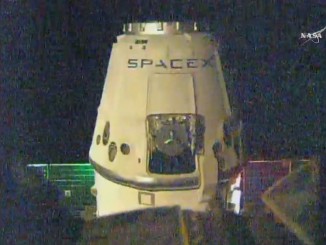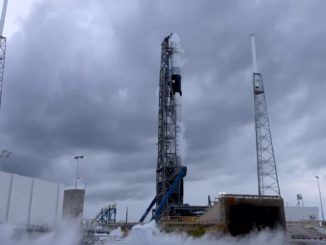
In the home stretch of nearly a half-year on the International Space Station, four astronauts suited up and rode their SpaceX-owned Crew Dragon “Resilience” spaceship to a new docking port outside the orbiting research lab Monday, a first-of-its kind maneuver for the new generation of commercial crew spaceships.
The maneuver clears the way for arrival of the next SpaceX Crew Dragon mission at the space station later this month, and sets up for the docking of a Dragon cargo freighter in June carrying a new pair of solar arrays to upgrade the outpost’s power system.
Commander Mike Hopkins, pilot Victor Glover, and mission specialists Soichi Noguchi and Shannon Walker suited up in their SpaceX-made pressure garments and boarded their Crew Dragon Resilience spacecraft early Monday. All four astronauts were aboard the Crew Dragon, which also serves as their lifeboat, for the relocation maneuver in case problems prevented the spacecraft from reconnecting with the space station, forcing an early return to Earth.
After closing hatches between their capsule and the space station, the astronauts configured their cockpit displays as ground teams gave a final “go” for the relocation maneuver.
The capsule detached from the forward docking port on the space station’s Harmony module at 6:30 a.m. EDT (1030 GMT) and fired its Draco thrusters to back away to a range of more than 200 feet, or 60 meters.
Undocking confirmed. The Crew Dragon Resilience spacecraft — with four astronauts on-board — is now backing away from the International Space Station to begin the maneuver to relocate to a different docking port.
Watch live: https://t.co/reM7dZtvvc pic.twitter.com/gy8uf5uY0u
— Spaceflight Now (@SpaceflightNow) April 5, 2021
After ensuring the Dragon’s laser navigation system had a good lock on the space station, mission control gave the go-ahead for Hopkins to send a command for the spacecraft to reposition itself from the station’s forward docking axis to an approach corridor above the complex.
The Crew Dragon Resilience spacecraft performed the flyaround maneuver in autopilot mode. Once the capsule was aligned with Harmony’s top-facing, or zenith, docking port, Hopkins issued another command for the Crew Dragon to begin an autonomous final approach back toward the station.
The spacecraft docked with the station again at 7:08 a.m. EDT (1108 GMT), completing a 38-minute relocation maneuver that was the first of its kind for a commercial crew vehicle.
Russian Soyuz crew capsules have relocated to different docking ports 19 times in the history of the International Space Station program. Unlike the Crew Dragon, the Soyuz spacecraft are relocated manually with hand inputs from Russian cosmonauts.
“SpaceX, Houston, from Resilience, congratulations on a successful port relocation,” radioed Hopkins from the Crew Dragon spacecraft. “We’ve got leak checks to go, but a great capability that’s going to really enhance the options up here for the International Space Station, so congratulations.”
Spacecraft relocations are useful for mission planners to open up docking ports for different types of visiting crew and cargo vehicles.
Docking confirmed.
The Crew Dragon Resilience and its four astronauts have linked up with a docking port on the top side of the space station’s Harmony module, clearing the way for arrivals of new crew and cargo capsules, and a new set of solar arrays.https://t.co/reM7dZtvvc pic.twitter.com/QMGbUiOwCw
— Spaceflight Now (@SpaceflightNow) April 5, 2021
The astronauts planned to enter the space station again later Monday morning to resume normal work.
Hopkins’s crew launched Nov. 15 aboard the Crew Dragon spacecraft, which they named Resilience, from NASA’s Kennedy Space Center in Florida, kicking off the first fully operational flight of a SpaceX crew capsule. Their mission, known as Crew-1, docked with the International Space Station the next day.
NASA astronaut Kate Rubins, who was aboard the Soyuz MS-17 spacecraft when it swapped docking ports last month, said last week the relocation is “not just a pleasure trip.”
“It’s all of the fun and the work of undock day, plus all of the fun and the work of docking day,” Rubins said, speaking from recent experience. “It’s a lot of activity. But it’s pretty cool, and it is quite an amazing view to separate from your vehicle that’s been your home for months and to be able to look at it from 60 meters.”
The relocation Monday clears the way for the next SpaceX crew mission to dock with the forward position on the Harmony module. SpaceX’s Crew-2 mission mission, set for launch April 22 from the Kennedy Space Center, will carry commander Shane Kimbrough, pilot Megan McArthur, Japanese astronaut Akihiko Hoshide, and European Space Agency astronaut Thomas Pesquet.

Hopkins and his crewmates are scheduled to end their mission April 28 with a departure from the space station and a fiery re-entry back into Earth’s atmosphere, culminating in a parachute-assisted splashdown off the coast of Florida.
Their undocking April 28 will then clear the top port on the Harmony module for the arrival of the next SpaceX Dragon cargo mission scheduled for launch June 3. NASA wants the Dragon cargo ship to dock with Harmony’s zenith port, within the reach of the space station’s Canadian-built robotic arm, which will extract a new pair of solar arrays from the Dragon’s trunk to upgrade the orbiting lab’s power system.
“We’ve got some pretty big milestones coming up, so let’s not take our foot of the gas and make sure we’re keeping our eye on the ball,” Hopkins said Friday.
Email the author.
Follow Stephen Clark on Twitter: @StephenClark1.



